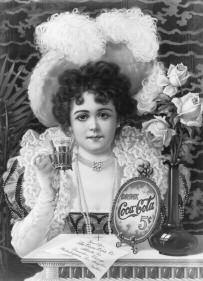Coca-Cola Co. history
A beverage company founded by John S. Pemberton in 1886, Coca-Cola became the most recognizable brand in the world. When the company was founded, soda beverages were considered medicinal, to be taken for minor stomach ailments. Root beer had been introduced 10 years before, and Coke’s major rival, Pepsi Cola, was founded 10 years later. However, when drinking alcoholic beverages became less fashionable and Prohibition became law, soft drinks became more popular, and Coke soon became the most popular brand.
Pemberton concocted the drink in a vat in his backyard and sold the first batch to Jacobs Pharmacy in Atlanta in 1886. The store sold the first drinks to customers for 5 cents each. Sales for the first year totaled around $50, but within 10 years the beverage became the most popular soda fountain drink. The script that became the company’s logo was designed by Pemberton’s accountant, who wrote the name longhand. An Atlanta businessman, Asa Candler, acquired ownership of the company in 1891 and then began marketing it nationwide. Three years later, the first factory to manufacture the syrup outside Atlanta was opened in Dallas.

In 1906, Coke was manufactured outside the United States for the first time, in Cuba and Panama. The Roots Glass Company designed what became the famous contoured bottle in 1915, and it, too, became a symbol of the beverage. By 1917, more than 3 million bottles were sold per day. A group of Atlanta businessmen bought the company in 1919 for $25 million. Coke had already implemented its own unique distribution system of allowing independent bottlers to brew and distribute the product. The franchise system of bottling and distribution became an industry standard that still exists today.
By 1920, more than 1,000 bottlers existed selling the product in the United States and abroad. Under Robert Woodruff, the company began emphasizing bottle sales, and the company began a series of promotions for which it would become famous in the advertising world. Woodruff remained at the helm of the company for six decades and was responsible for its exponential growth and popularity. In 1928, the company established a link with the U.S. Olympic Committee by donating a thousand cases to athletes. By 1940, the beverage was bottled in more than 40 countries. The brand name became so well established that by the 1960s the term Coca- Cola imperialism began to be used to identify the export of American pop culture.
In the early 1980s, Roberto Goizueta was named chairman, and the company began introducing other products to its line in response to the continuing challenge by Pepsi. Not all of the new products and innovations, such as the “New Coke” product and its accompanying ad campaign, proved successful, but the company retained its hold on both its market and its brand name after Goizueta’s death in 1997.
Further reading
- Allen, Frederick. Secret Formula: How Brilliant Marketing and Relentless Salesmanship Made Coca-Cola the Best-Known Product in the World. New York: HarperBusiness, 1994.
- Hoy, Anne. Coca-Cola: The First 100 Years. Atlanta: Coca-Cola, 1986.
- Pendergrast, Mark. For God, Country and Coca-Cola. New York: Scribner’s, 1993.
Tweet